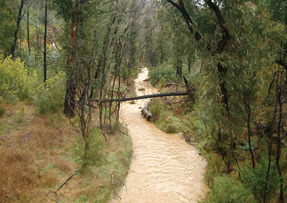Bushfires commonly cause an increase in stream turbidity. The Lower Cotter Catchment is part of the main water supply catchment for Canberra, and land in the catchment has been historically managed for a mix of conservation (native eucalypt forest) and pine (Pinus radiata) plantations. The catchment has highly erodible soils that, if exposed, can result in increased stream turbidity, negatively affect stream ecological condition and increase water treatment costs.
Turbidity assessment in the Lower Cotter Catchment
The 2003 bushfire burnt almost all of the Lower Cotter Catchment. In 2005, the University of Canberra (funded by ACT Parks and Conservation) studied the site to determine if stream turbidity in the catchment had recovered postfire. Turbidity data loggers were deployed in Lees and Condor creeks to determine turbidity response to fire in these areas.13
After the fire, turbidity levels went up, because of run-off from exposed highly erodible soils. Following increased vegetation cover in the catchment (from both natural recovery and plantings) and remediation work (eg road closures to reduce sediment run-off from roads), turbidity levels have decreased.

Underwater photo of a turbidity logger in Condor Creek. Photo: University of Canberra
a

b

In Condor Creek, turbidity was (a) high in 2005, and (b) low in 2014. Photos: University of Canberra